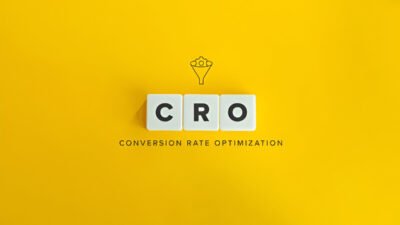But those visitors aren’t doing anything? Don’t worry, if this sounds like your business. There are many companies that turn clicks into sales, not tables conversely.
CRO (Conversion Rate Optimization) comes in here.
CRO uses data-driven insights, customer analysis of behavior, and strategic adjustments to increase the percentage of visitors to your site who do what you want them. That could be anything from purchasing one product with twice the quantity to signing up for a newsletter or even simply downloading one resource from your website.
This blog will take you through the basic steps to start your CRO. By following this guide, you’ll be in a good position with knowledge and results that are visible for everyone to see.
What is CRO (Conversion Rate Optimization)?
First, let’s define it before we get into the steps.
CRO (Conversion Rate Optimization) is the process of improving your site or landing page in order to get a higher percentage of visitors who complete a specific action. The “conversion” can be anything that helps advance towards your business objectives, such as filling out forms, making purchases and even spending more time on site. Learn more about CRO (Conversion Rate Optimization)
For example:
If 100 people to your site and 5 of them signing up for the newsletter, your conversion rate is 5%. By doing CRO you want to nudge this number upward, even only by 0.1%, because a small change in conversion rates means big money.
Why is CRO Important?
CRO can make this tiny gap in your conversion rates into a vast distance. Here’s why it works:
- Increases marketing Return on Investment (ROI): You will get more conversions without increasing traffic; that way each dollar spent is worth more than it ever was before.
- Users experience improvement: CRO usually involves making your website more intuitive and engaging, which is bound to have users raving about it.
The greater number of conversions you have, the better your return on investment will be.
Six Steps to Starting Conversion Rate Optimization
1. Define Your Goals and Metrics
Get started with your CRO plan by defining a clear objective. That means setting both your main conversion targets (macro-conversions) and secondary ones (micro-conversions).
Macro-conversions:
This is what you’re ultimately aiming for—things like sales or subscriptions. The main goal of all your work on CRO should be to move a customer toward a pay moment.
Micro-conversions:
These elements are the steps leading up to that main goal, such as adding products into a shopping cart or signing up for a trial.
Key metrics to monitor:
- Conversion rate
- Bounce rate
- Exit rate
Having clearly defined outcomes focuses your efforts and helps you make sure they are on the right track to achieve their goals.
2. Know Your Audience
To start your journey down CRO’s road, you need to know your visitors intimately. So ask yourself:
- Who are these people who come to the website?
- What do they want from it?
- What’s preventing them from doing what we hope they would?
How to uncover specific customer behavior:
- Use Google Analytics — search through all the data and try different ways of slicing it. Look not just at whole pages, but individual sections within a given page for patterns.
- Heatmap Analysis — Crazy Egg and Hotjar are tools that let you see where visitors are clicking or scrolling.
- Survey Your Visitors — Pop up surveys or an email asking people why they left what they were trying to do can reveal some points of friction always.
3. Do a Website Audit
Think of an audit as a health check for your website’s performance. Aspects to be reviewed include:
- Page Load Times
It’s very annoying to wait half a minute for your page to come up. Aim for a load time of 2 seconds or less. - Design and Navigation
Is your site easy to use? Visitors who can’t cope will soon disappear. - Mobile Optimization
About 60% of all internet traffic is mobile. Your site should also work on any size screen.
Use tools like Google’s PageSpeed Insights or SEMrush’s Site Audit Tool to identify inefficiencies.
4. Form a Hypothesis
CRO isn’t about making random changes and crossing your fingers. It’s about identifying specific problems and testing solutions based on data.
Make a hypothesis.
Take advantage of this opportunity to use the data you just went through.
Example:
Problem: Visitors aren’t completing the signup form.
Hypothesis: Adding a progress bar to the form will make the process feel quicker, increasing submissions.
Focus on one change at a time to measure its real impact effectively.
5. Run A/B Testing
One of the most effective CRO tools is A/B testing (also called split testing). It involves creating two versions of a webpage or element and seeing which performs better.
Example:
- Version A: Keep the original “Sign Up” CTA button on a white background.
- Version B: Test a red “Sign Up Now” button with bold text.
To conduct a successful test:
- Use tools like Google Optimize, Optimize, or VWO.
- Run the test for a set period.
- Ensure a statistically significant sample size.
- Track key metrics like clicks, conversions, and bounce rates.
6. Analyze Results and Iterate
Once testing is complete, analyze the results to find out if your hypothesis was correct.
Whether the results are desirable or otherwise, every test is useful in terms of education. If the change works, be sure to apply similar optimizations across other areas of your site. If the change doesn’t work, work out why and try again.
CRO is a process that’s always ongoing. Continuous testing and iteration will lead to long-term success.
Pitfalls to Avoid When Doing Common CRO
When you are just getting started with CRO, watch out for these traps:
- Neglecting Mobile – Not making mobile and tablet experiences count big time for conversion could land you in trouble.
- Relying on Gut Feelings Instead of Data – Every change must be made based on evidence, not guesswork!
- Testing Too Many Variables Simultaneously – Concentrate on one variable at a time.
- Stopping Tests Too Soon – The more meaningful data is collected, the better.
Turbocharge Your Site with CRO
When you first begin conversion rate optimization, you might feel like it’s a lot to take in. But any work is worth doing if it gets results.
By figuring out who your audience is, making data-backed hypotheses, and establishing a culture of continuous improvement, you’ll slowly turn the tide and start to get more conversions. Over time you will see measurable business growth.
If you want to push your conversion rate optimization to new heights, then there’s no time like now for getting down to some testing. Get your site out of the slow lane and onto the fast track today!





